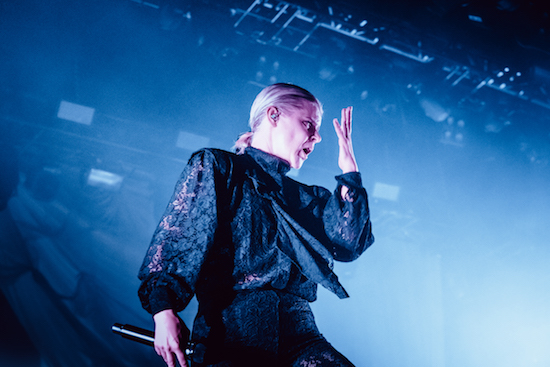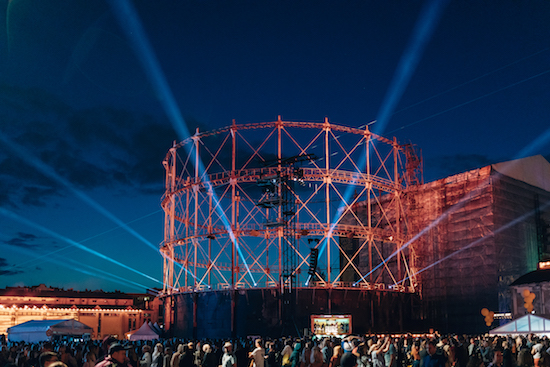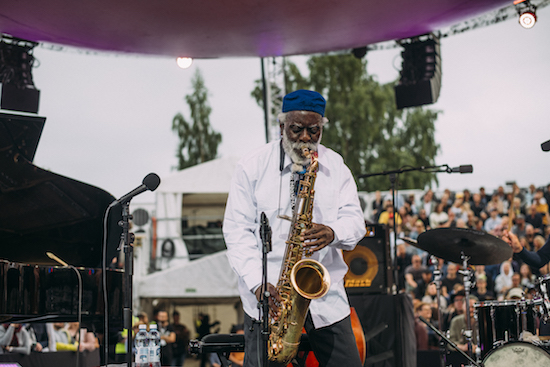Celebrating its 15th anniversary, Helsinki’s Flow Festival has nicely positioned itself as one of Europe’s best music events whilst also retaining something of an undiscovered charm to it – mainly given that it’s free from hordes of travelling Brits. Its location in a defunct power plant in the city centre is pretty much perfect and provides impressive backdrops of gas holders and chimney stacks, which when illuminated by projections of an evening make it feel like a distinctly unique place to be.
Uniqueness is an increasingly difficult thing to come by for festivals of this size and stature, as line-ups can often mirror many other European festivals. However, Flow – via its inimitable location and heavy focus on Finnish acts – manages to feel like it possesses its own clear personality and identity. Also, whilst music never feels like a secondary consideration, the food on offer is some of the best you’ll taste at any music festival in any country. Likewise its impassioned commitment to environmental practices (discussed more below) is one that more festivals need to be looking to and emulating.
So, after three days and nights spent wandering the nooks and crannies of an old power plant as performances by the likes of The Cure, Earl Sweatshirt, Erykah Badu, Tame Impala, Yves Tumor, Mitski, Amnesia Scanner, Slowthai and Stereolab rang out, here’s what was learned at this year’s edition.
Pharoah Sanders Feels As Fresh As Ever
At 78 years old, when Pharoah Sanders climbs the steps to the stage he does so with a security guard on each arm and is bent and hobbled over so far he almost looks like he might topple if not propped up. He might initially cut the image of an elderly man who may struggle to lift a saxophone let alone play one but as soon as he picks it up and puts his lips to the reed the sense of interconnectivity he has formed with that instrument over five decades radiates from the soothing notes that ooze out. As ‘The Creator Has A Master Plan’ unfurls, it fizzes with life and pulsates with a sense of wonder and discovery as it moves in beautiful and unpredictable waves.
Playing as a quartet, admittedly it’s his band that do most of the heavy lifting and animated playing but what Sanders contributes is worth savouring and holding on to. If this feels like something of a victory lap then it’s a most deserved one. With sounds and techniques that he helped lay the foundations for so many years ago having something of a moment and resurgent right now, there’s a sense that we’re paying tribute to him by watching this performance.
Old heads aren’t the ones hogging the front row barriers; instead there is a new generation of jazz fans who weren’t even born by the time Sanders had cut his first 30 records. The last rays of sun shine down and the music that pulses from the stage almost seems to combine with it to create a sparkling incandescent moment that is truly special and – without meaning to sound all Jo Whiley “Glasto moment” – captures the essence of what makes festivals at their best such magical places for being caught in a perfect moment.

The Transcendent Joy Of Robyn
Robyn’s role in pop is something that goes so much further beyond having a few bangers. The intense feeling of melancholy and joy she can balance within a single song creates a stirring concoction of emotions. When further propelled by, at times, straight-up pummelling techno, it brings something special out of the audience. During ‘Dancing On My Own’ she has to stop the song just to make space for the elongated rousing applause that has grown louder than the music itself.
A powerful catharsis takes place between audience and artist as tears begin to jet forth from the eyes of many in the audience. By the time she is allowed to re-enter the song, it takes on an even deeper significance and profound sense of beauty as a physical eruption seems to takes place. The set is peppered with such joyous, transcendent moments that are not only an ode to the unifying and dazzling power of pop music but also in capturing the multifaceted depth of Robyn’s music.
Nitzer Ebb Couldn’t Feel More Out of Place
Whilst Flow’s line-up is generally an eclectic one that spans indie, jazz, pop, folk, electronica, hip hop and dance, there’s nobody else on the bill quite like Nitzer Ebb. When Douglas McCarthy arrives in shades and a suit and begins prowling the stage, his hand regularly grabbing his crotch in thrusting bursts as Bon Harris spits out clattering throbs of industrial EBM, they feel like a product of a bygone era.
However, as the only outfit coming close to performing this kind of tone, tempo and attack the result is one that celebrates and emphasises their most welcome uniqueness. When bands play festivals they are always very much playing in the environment that the festival creates and are bound by what they have to work with. In short, making a space feel their own can be difficult. However, in the suitably named Black Tent, Nitzer Ebb manage to create an escapist experience. The screams of “muscle and hate” during ‘Join In The Chant’ rage from the stage as pogoing audiences members ricochet like pinballs, the band manage to extract the root and joy of their music in a way that doesn’t feel like nostalgia but completely in the moment.
Bands such as Nitzer Ebb have often fallen into the bracket of serious industrial music but there’s such a looseness, pleasure and naughtiness to their work that totally belies such a rigid framework. Their set remains a stand out of the weekend as a result.

Solange Is Great Even In Stone Cold Silence
Punctuality is a big thing in Finland; it’s something that is culturally embedded into their way of life and approach to all things. Along with honesty, it’s a trait that is considered to be non-negotiable. An admirable mannerism but one that Solange feels the brunt of. Brought in to replace Cardi B, she plays a stunning headline set.
There’s shirtless men in cowboy hats, high-intensity twerking that moves so fast you feel like you’re having a seizure, a brass-heavy full band and a simple yet elegant stage set up that revolves around a giant set of white stairs. The performance is both subtle and stirring. Perhaps she’s a little lacking in knockout hits – in the conventional anthemic festival headline set way – but there’s an assuredness to the performance that make it a pleasingly diverse headline set.
The drum smack that begins ‘Cranes In The Sky’ rings out like thunder around the arena but instead of precipitation, something much more warm and glowing follows. The nuance, subtlety and poised delivery is shimmering. Whilst the ongoing contemporary proclivity for smooth music at times borders on anaemic, Solange seems to sit perfectly in the middle between swinging and smooth grooves.
However, as midnight rolls around the sound is cut. Curfew has been reached and the punctuality kicks in without mercy. The last five minutes of the show is nothing but silence except for the unamplified sound of the drums and brass. Dancers continue to move fiercely and Solange continues to sing with gusto. There’s a strange beauty to watching a fully choreographed show taking place in deadly silence and whilst it’s disappointing to miss the closing of the set, it proves that Solange is an engrossing performer – even when she has the plug pulled on her.
Trees Are Good
If music festivals are going to continue to exist in the way they are currently structured – i.e flying in people from various parts of the world to perform – then they should be expected to take environmental measures that will offset their impact. Festivals such as Glastonbury banning single-use plastic is an important and long overdue step but still much more needs to be done. Both as a festival, and culturally as a country, the commitment (at Flow and in Finland) shown to sustainability and environmental consideration is truly impressive. It is not in any way a tokenistic or box-ticking approach but instead is fundamentally embedded into how the place is thought about and designed.
Not only are all food vendors on site forced to offer sustainable meal options (along with around 50% non-meat options) and single-use plastic is banned across the site and all consumables being recyclable but the festival also set up a donation bank so that instead of getting your €1 deposit back for your can, you can donate it instead and a tree will be planted for every donation. Over the weekend nearly 12,000 cans were donated to the Finnish Environment Institute’s reforestation project, which will see the trees planted in Madagascar as a result.
In fact trees are so beloved and omnipresent here in Finland – home to some of the densest forests in the world and home to around 22 billion of them – that they’ve even managed to plant some on the old power plant site.
The role they play on the Resident Advisor stage also plays a crucial one. The concrete-site hides a little corner for the stage and the trees stand large and monolithic in the middle and so during sets by the likes of The Black Madonna and a brilliantly pumping techno set from Nina Kravitz, you can immediately feel like you’re transported somewhere else within minutes – from a post-industrial site to a forest. Ravers dance in the trees and the fact they block the view of the stage from most spots, means that it kills that stand still and stare at the DJ vibe that can often come from the outer fringes. It’s such little touches and thoughtful planning that make the site such a fun one to take in and explore, as the fossil industry of the past is being overtaken by a place that has more progressive and less destructive plans for it.


